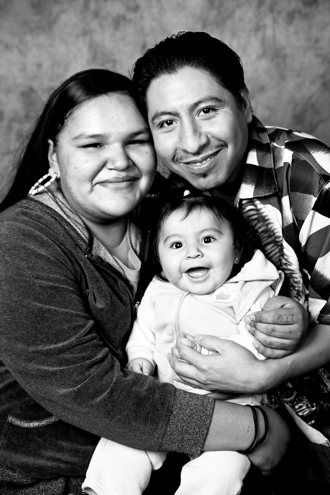
In their portrait on exhibit at St. John Neumann in Eagan, a smiling couple identified as Alisha and Emiliano who are holding their tiny daughter look like any other young family.
But dial the phone number listed below the large, black-and-white photo and the St. Louis Park couple tells in a recording how they lived for a year in a family member’s van, moving when it was too cold to shelters and the homes of family and friends.
In overcoming the difficulties of homelessness — they eventually found an apartment and made a new start — they also speak of hope and happiness. “Don’t give up!” Emiliano exhorts.
Alisha and Emiliano’s picture is one of 50 portraits of Minnesotans who have experienced homelessness that make up an exhibit titled “Homeless is My Address, Not My Name,” on display at the parish during Lent.
“It’s so counter to what you would think of as an exhibit of pictures of homeless people,” said parishioner Bob Brezinski, who proposed bringing the photos to St. John Neumann. “Most people have smiles and their countenance is hopeful, upbeat, promising.”
Raising awareness

The exhibit has stirred up curiosity and awareness of the plight of the homeless at a parish that already serves them and others in need through a range of ministries. Faith formation leaders also are involving parish youth in the exhibit.
In bringing the photos to St. John Neumann, Brezinski along with a charity and justice ministry he leads, hope more parishioners will decide to serve.
“Our hope is this will sensitize more people to the difficult situation of people who are homeless and that we’ll get more people to come forward and volunteer to be part of these ministries that serve people in these situations,” he said.
Along with displaying portraits in the church’s social hall, organizers have strategically rotated others in high traffic areas around the church premises to attract attention, he said.
Half the professionally-done 20-by-24-inch portraits are accompanied by telephone numbers that connect to a voicemail box containing a recorded narrative of the subjects of the photos so visitors can listen to the stories as they view the portraits.
The ongoing project was developed in 2008 by the Minneapolis non-profit St. Stephen’s Human Services in partnership with several other regional organizations to document homelessness in the state, according to Margaret Miles, development and communications director for St. Stephen’s Human Services, which assists the homeless.
Six volunteer photographers and nearly three dozen interviewers have created 700 portraits and first-person narratives so far, she said. In the past several years, the exhibit has been displayed at churches and social service organizations, and the Minnesota Historical Society eventually will archive the portraits and narratives, Miles said.
Exhibit developers hope viewers will gain an understanding of the ways people become homeless, how they cope and how they get out of it, said Miles, noting that many of the people pictured are no longer homeless.
Parish youth are being challenged to see Christ disguised in the faces in light of the Gospel parable of the sheep and the goats (which stresses the need to show kindness and mercy toward the disadvantaged), said Pat Howard, youth catechesis director for 600 kids in grades six to 12.
“I think many of them have ‘seen’ a homeless person — being downtown, driving and seeing somebody they thought was homeless,” he said. “But now to see these portraits [in] which they have varying expressions on their faces and many of them joyful and then to hear their personal stories. . . . It really can change things.”
Facing the issue
The exhibit also has sparked discussion among adult parishioners. Liz Lutton said she found it “beautifully done and very poignant. It gives you pause to think we are rich in many things — home, family, enough to eat,” she said.
According to Kristin Fahrendorf, the images “capture people’s dignity and sadness. They’re smiling but they’re not necessarily happy.”
The portraits are “in your face” for good reason, Howard noted.
“They’re everywhere and there’s no escape, which is sort of the way the Gospel should be presented, that there’s no escape from what Jesus is calling me to,” he said. “Jesus is calling me to take the faith and not have it be some abstract in my life but to have it be real and lived.”



